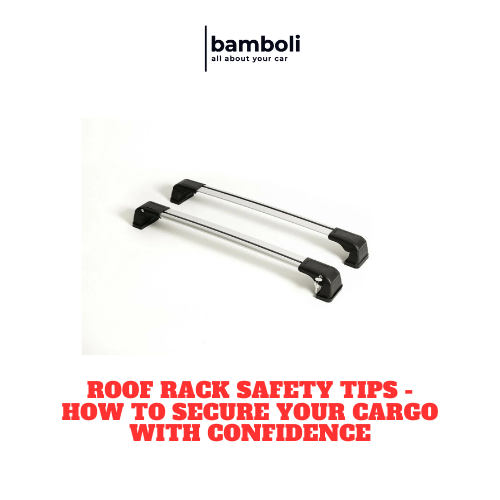Roof Rack Safety Tips - How to Secure Your Cargo with Confidence

Transporting cargo on the roof of your vehicle, safety should always be your top priority. Roof Rack Safety Tips: How to Secure Your Cargo with Confidence offers essential guidance on how to properly secure your belongings for a worry-free journey. Whether you're heading out on a road trip or simply need to transport a few items, following these tips will ensure that your cargo stays secure and your drive remains safe.
Main Points
- Choose the right roof rack for your vehicle
- Secure your cargo properly using straps or bungee cords
- Distribute the weight evenly
- Check the roof rack and cargo periodically during your journey
- Drive cautiously and obey speed limits
Choosing the Right Roof Rack for Your Vehicle
Finding the perfect roof rack for your vehicle, there are several factors to consider. Whether you're an avid outdoor enthusiast or need extra storage space for road trips, selecting the right roof rack is crucial. Here are some key points to keep in mind:
- Determine Your Needs
Before making a purchase, assess what you will primarily be using the roof rack for. Are you transporting bikes, kayaks, skis, or luggage? Knowing your specific needs will help narrow down the options and ensure you choose a rack that meets your requirements.
- Consider Your Vehicle
Not all roof racks are compatible with every vehicle. Take into account the make and model of your car, as well as any existing roof rails or crossbars. Some racks require a specific type of mounting system, so it's essential to confirm compatibility before buying.
- Think About Installation and Removal
Some roof racks are easier to install and remove than others. If you plan on frequently taking the rack on and off, consider a model that offers quick and straightforward installation. This will save you time and effort when loading and unloading your gear.
- Review Weight Capacity
Each roof rack has a maximum weight capacity that it can safely support. It's crucial to adhere to these guidelines to prevent damage to both the rack and your vehicle. Overloading the rack can also affect your car's handling and fuel efficiency.
- Look for Durability
Invest in a roof rack that is made from high-quality materials and designed to withstand various weather conditions. A durable rack not only ensures your gear stays secure during transit but also has a longer lifespan, saving you money in the long run.
- Check for Security Features
Security is key when it comes to transporting valuable equipment on your roof. Look for racks that come with locking mechanisms or the option to add security accessories. This will give you peace of mind knowing your gear is safe from theft.
By taking these factors into consideration, you can choose the right roof rack for your vehicle that suits your needs and provides reliable performance on all your adventures.
Properly Loading and Distributing Your Cargo on the Roof Rack
Transporting items using a roof rack, proper loading and distribution of the cargo are key factors in ensuring a safe and smooth journey. Whether you are heading out on a road trip or simply need to transport some gear, following these tips will help you make the most of your roof rack.
- Pack Strategically
One of the most important aspects of loading your cargo on a roof rack is to pack strategically. Weight distribution plays a crucial role in maintaining the stability of your vehicle, so make sure to evenly distribute the weight of your items. Place heavier items towards the center of the roof rack and lighter items towards the outer edges to keep the load balanced.
- Secure Your Cargo
Properly securing your cargo is essential to prevent it from shifting or coming loose during transit. Use tie-down straps or cargo nets to secure your items to the roof rack. Double-check that everything is tightly fastened before hitting the road to avoid any accidents or damage to your belongings.
- Maximize Space
Make the most of the available space on your roof rack by utilizing storage containers or bags. This will not only help you organize your items more efficiently but also protect them from the elements. Opt for weatherproof containers to keep your belongings safe from rain, dirt, and other external factors.
|
Tip |
Summary |
|
Pack Strategically |
Evenly distribute weight for stability |
|
Secure Your Cargo |
Use tie-down straps to prevent shifting |
|
Maximize Space |
Utilize storage containers for efficient organization |
By following these guidelines for properly loading and distributing your cargo on the roof rack, you can ensure a safe and hassle-free journey every time. Remember to always double-check your cargo before hitting the road to avoid any potential risks or accidents.
Securing Cargo Safely: Understanding Tie-Down Straps and Accessories
When transporting goods, it is crucial to ensure that your cargo is securely fastened to prevent any accidents or damages during transit. One of the most common and effective ways to secure cargo is by using tie-down straps and accessories.
Tie-down straps come in various forms, such as ratchet straps, cam buckle straps, and bungee cords. These straps are made from sturdy materials like polyester or nylon, designed to withstand heavy loads and rough handling. Using the right type of tie-down strap for your cargo is essential to ensure a secure hold.
Here are some key points to consider when using tie-down straps:
- Tension:Proper tension is crucial when securing cargo. Make sure to tighten the straps enough to hold the load in place, but be cautious not to over-tighten, which could damage the cargo or the strap itself.
- Anchor Points:Always attach the straps to secure anchor points on your vehicle or trailer. Avoid tying down cargo to weak or unstable points that could come loose during transport.
- Inspections:Before each trip, inspect your tie-down straps for any signs of wear or damage. Replace any worn-out straps immediately to ensure the safety of your cargo.
By understanding the importance of using tie-down straps and following these key points, you can secure your cargo safely and prevent any potential accidents on the road.
Regular Maintenance: Keeping Your Roof Rack in Top Condition
Regular maintenance is key to ensuring that your roof rack remains in top condition. By taking the time to properly care for your roof rack, you can extend its lifespan and avoid costly repairs down the road. Here are some tips on how to keep your roof rack in tip-top shape:
- Inspect Your Roof Rack Regularly
Make it a point to visually inspect your roof rack on a regular basis. Look for any signs of damage, such as rust, corrosion, or loose bolts. Addressing these issues early on can prevent further damage and ensure the safety of your cargo.
- Clean Your Roof Rack Thoroughly
After every trip, take the time to clean your roof rack thoroughly. Remove any dirt, debris, or salt buildup that could cause damage over time. Use a mild soap and water solution, and be sure to dry your roof rack completely before storing it.
- Lubricate Moving Parts
Keep your roof rack running smoothly by lubricating any moving parts on a regular basis. This includes hinges, locks, and adjustable components. Using a silicone-based lubricant will help prevent rust and corrosion.
- Check Weight Limits
Be sure to check the weight limits of your roof rack and adhere to them. Overloading your roof rack can cause damage to both the rack and your vehicle. If you are unsure of the weight limits, consult your vehicle's manual or the manufacturer.
- Store Your Roof Rack Properly
When not in use, store your roof rack in a clean, dry area. Avoid exposing it to extreme temperatures or harsh weather conditions. Storing your roof rack properly will help prevent damage and prolong its lifespan.
Roof Rack Maintenance Tip:
Regular maintenance is essential for keeping your roof rack in top condition. By following these simple tips, you can ensure that your roof rack remains safe, functional, and reliable for all your adventures.
|
Step |
Description |
|
1 |
Inspect Your Roof Rack Regularly for any signs of damage |
|
2 |
Clean Your Roof Rack Thoroughly after every trip |
|
3 |
Lubricate Moving Parts to keep your roof rack running smoothly |
|
4 |
Check Weight Limits to avoid overloading your roof rack |
|
5 |
Store Your Roof Rack Properly in a clean, dry area |
Weather Considerations: How to Safely Transport Cargo in Rain, Wind, and Snow
Transporting cargo, weather conditions play a crucial role in ensuring the safety of both the goods being transported and the individuals responsible for transportation. Rain, wind, and snow can all pose unique challenges that need to be addressed in order to prevent accidents and damage to the cargo. Here are some tips on how to safely transport cargo in these weather conditions:
- Rain:
Visibility is key when driving in rainy conditions. Make sure to turn on your headlights, reduce your speed, and keep a safe distance from other vehicles on the road. Additionally, check your windshield wipers and ensure they are working properly to maintain a clear view of the road.
- Wind:
When dealing with strong winds, it's important to secure your cargo properly to prevent it from shifting or flying off during transit. Utilize straps and tie-downs to secure the load and avoid driving in windy conditions if possible. Stability is crucial when transporting cargo in windy weather.
- Snow:
Driving in snowy conditions requires extra caution. Make sure your vehicle is equipped with snow tires or tire chains for better traction. Slow down, avoid sudden movements, and leave plenty of room between vehicles to allow for safe braking. Preparation is key when transporting cargo in snowy weather.
By following these tips and paying attention to weather forecasts, you can ensure the safe transportation of cargo in rain, wind, and snow. Remember, safety should always be the top priority when transporting goods in challenging weather conditions.
Legal Aspects and Safety Regulations for Using Roof Racks
Using roof racks on your vehicle, it is important to be aware of the legal aspects and safety regulations that govern their use. Failure to comply with these regulations can not only result in fines and penalties, but also pose a serious safety risk to you and other road users.
Legal Requirements
In most countries, there are specific laws and regulations that dictate how roof racks should be used. These regulations typically cover the maximum weight that can be carried on a roof rack, as well as how the load should be secured to prevent it from shifting or falling off while driving.
It is **essential** to familiarize yourself with the legal requirements in your area before installing a roof rack on your vehicle. Failure to do so could result in **serious** consequences.
Safety Considerations
In addition to legal requirements, it is also important to consider safety when using a roof rack. Make sure to follow the manufacturer's instructions for installing the roof rack properly, and regularly inspect it to ensure that it is in **good** condition.
Always remember that safety should be your top priority when using a roof rack. It's better to be safe than sorry.
|
Maximum Weight Limit |
Securing the Load |
Regular Inspections |
|
Make sure not to exceed the maximum weight limit specified by the manufacturer. |
Always secure the load properly using straps or tie-downs to prevent it from shifting or falling off. |
Regularly inspect the roof rack and the load to ensure that everything is secure and in good condition. |
Frequently Asked Questions
How should I properly secure items on the roof rack?
Make sure to use appropriate tie-down straps and follow the manufacturer's guidelines for securing cargo on the roof rack. It's important to distribute the weight evenly and secure the items tightly to prevent shifting during transit.
Can I exceed the weight limit recommended for my roof rack?
It is not advisable to exceed the weight limit specified by the manufacturer for your roof rack. Overloading the roof rack can compromise safety and potentially damage your vehicle.
Are there any specific items that should not be carried on a roof rack?
Certain items such as flammable materials, liquids, or fragile items should not be carried on a roof rack due to safety concerns. Always check the manufacturer's recommendations for the types of cargo suitable for your roof rack.
How often should I check the tightness of the straps securing my cargo?
It is recommended to regularly inspect the tightness of the tie-down straps while on the road to ensure that the cargo remains secure. Stop periodically during your trip to check and tighten the straps if needed.
What should I do if I hear unusual noises coming from the roof rack during my drive?
If you hear unusual noises such as rattling or shifting coming from the roof rack, pull over safely to investigate and secure the cargo. Address any issues promptly to prevent potential accidents or damage to the roof rack.




